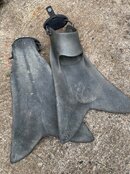Great video, thanks.I have close to 400 dives at Marineland, one of our local SoCal sites. I consider myself pretty knowledgeable about when to or not to dive there and how to enter/exit. Merry was filming me exit one day when the surf was calm. I was in less than a foot of water, just a step or two from the shore, when I slipped and fell to my knees. D-oh! The rocky bottom moves with even the slightest water movement.
You are using an out of date browser. It may not display this or other websites correctly.
You should upgrade or use an alternative browser.
You should upgrade or use an alternative browser.
Best way to enter water from the shore
- Thread starter RXTdiver
- Start date
-
- Tags
- entry shore diving techniques waves
Please register or login
Welcome to ScubaBoard, the world's largest scuba diving community. Registration is not required to read the forums, but we encourage you to join. Joining has its benefits and enables you to participate in the discussions.
Benefits of registering include
- Ability to post and comment on topics and discussions.
- A Free photo gallery to share your dive photos with the world.
- You can make this box go away
I didn't see any other divers but from my mistakes and reading suggestions here, I feel a lot more confident about doing this again.Are there any experienced divers (divers experienced diving the site you're attempting to dive) you can link up with? If so, you can learn from them how they do it. If there is a nearby dive shop, you can probably learn about local divers who you can link up with.
rx7diver
johndiver999
Contributor
I think an important aspect seems to have been omitted. You really want to sit at the beach and just watch the surf for 10 minutes or so. You can get an idea about the timing of the sets.
You want to enter and exit between the major sets. If you just watch for two or three minutes and decide it looks good and then get dressed and just enter when it is convenient, you can get hammered. It is somewhat more difficult to do when exiting, but sometimes it makes sense to wait for a big set to pass while you sit outside the break zone and rest and then sprint in after the big waves have passed.
I used to do a lot of night diving off the beach. When you really can't see the waves, you want to dial down your acceptable conditions.
It is also reasonable to consider that the seas can build while you are down and of course it may be very important to consider the tide cycle in certain areas, because the beach may look very different when the tide is in or out- especially over a rocky shore. When the tide is in, the area may be passible, with the tide out, you could be faced with a very shallow, rough and rocky bottom with sea urchins to traverse.
As others have said, if you are unsure about your abilities and the conditions, it is better to get in and check it out without scuba gear on. You can scramble over rocks, obstructions and waves a lot easier without a tank on.
Asking for guidance from the locals is always prudent.
Lastly, you want to have zero air in the BC when entering and crawl/swim on the bottom when trying to get from the beach to deeper water.
You want to enter and exit between the major sets. If you just watch for two or three minutes and decide it looks good and then get dressed and just enter when it is convenient, you can get hammered. It is somewhat more difficult to do when exiting, but sometimes it makes sense to wait for a big set to pass while you sit outside the break zone and rest and then sprint in after the big waves have passed.
I used to do a lot of night diving off the beach. When you really can't see the waves, you want to dial down your acceptable conditions.
It is also reasonable to consider that the seas can build while you are down and of course it may be very important to consider the tide cycle in certain areas, because the beach may look very different when the tide is in or out- especially over a rocky shore. When the tide is in, the area may be passible, with the tide out, you could be faced with a very shallow, rough and rocky bottom with sea urchins to traverse.
As others have said, if you are unsure about your abilities and the conditions, it is better to get in and check it out without scuba gear on. You can scramble over rocks, obstructions and waves a lot easier without a tank on.
Asking for guidance from the locals is always prudent.
Lastly, you want to have zero air in the BC when entering and crawl/swim on the bottom when trying to get from the beach to deeper water.
.
Similar threads
- Replies
- 32
- Views
- 2,144
- Replies
- 16
- Views
- 5,487
- Replies
- 114
- Views
- 12,862
- Replies
- 1
- Views
- 370
- Replies
- 10
- Views
- 792




